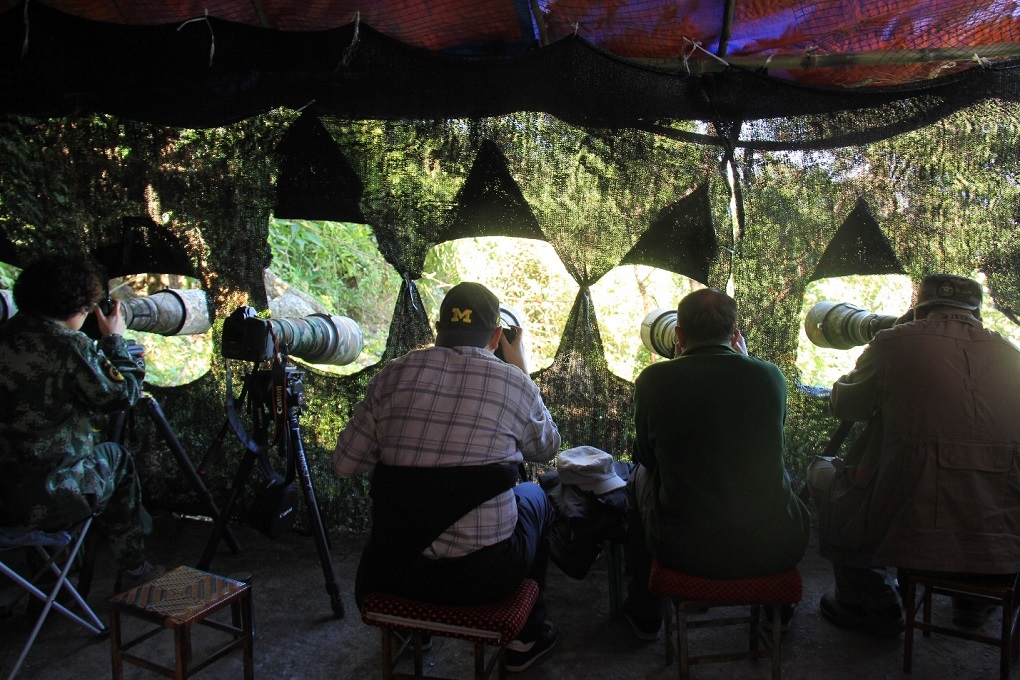The cool fresh breeze touched our skin despite the warm sunlight as we deplaned at the Baoshan Yunrui Airport. With excitement and enthusiasm we set off to our destination for a week of learning.
When we reached Gaoligongshan National Nature Reserve (GNNR), we were welcomed by a rush of gorgeous sounds: birds chirping, a murmuring stream, and the low hum of cicadas. GNNR covers more than 4,000 square kilometres, and is home to more than 200 species of wild animals, 525 species of birds, and 49 species of fish. The immense biodiversity of the reserve is matched only by its astonishing landscape and natural beauty.
The next morning, we set out down a birding trail that starts in the village and runs deep into the forest, and that was part of some important historical trails like the Silk Road. We peered through binoculars to identify the many species which filled the air with song. The first sighting was that of a Yunnan Fulvetta, a small grey-headed bird, foraging in a berry tree, surrounded by its fellows. The trail was dotted with die-hard ornithologists, enthusiastic birdwatchers, and younger people enjoying their time in nature.
Birdwatching in China is experiencing a paradigm shift from localised birdwatching to becoming part of a global tourist market. Unfortunately not much attention has been given to understand the impacts of tourism on bird populations and their habitat. There is a need to establish interlinkages between birdwatching ecotourism, environmental conservation and economic co-benefits. These need to be location specific, as the needs of one geographic terrain and the birds that inhabit them, will not be the same as that of others.
In 2009 an innovative approach to birdwatching emerged in China, in which enthusiasts gathered around ponds that were specially curated and managed by locals. Early reports are promising. In Hanlong, which is located Baihualing, pond bird watching accounts for 70% of the household income of participating families, according to a study conducted by ICIMOD & Southwest Forestry University (SWFU) in 2017.
This approach presents an option where birdwatching tourism is developed in such a way to integrate local socio-economic and ecological benefits. Locals have developed the bird watching interest into a small business, erecting bird hides near ponds where people can pay a small fee to watch and take photos. Social networking services like QQ, WeChat and bird-themed “BBS forums” have become the main channels for the local tourism service providers to market and communicate with their customers to schedule services ahead of time.

To the spectator, the ponds in GNNR stress the complex interplay of the beauty of nature and the need to develop this beauty for tourism in a manner that preserves the special qualities of the GNNR, a bird-watching paradise. This complex functioning at the same time made us realize that there are more layers for sustainable tourism and more strategies needed for increasing tourists. Few pond owners have focused on discrete techniques to attract the birds nearby, like mimicking their songs and sounds.
GNNR is organized according to a zone concept. The “core” zones are strictly protected areas that maintain the ecosystem in its natural state. The “experimental” zones are reserved for tourism activities and future development. The “buffer” zones mark areas that are between the core area and experimental zone to restrict resource use and developmental activities to enrich the protection of the reserve. Unlike national parks which are freely open to the public, GNNR is a reserve which provides more space for protection and development. There are restrictions against conducting tourism activities in the core and buffer zones, so all eco-tourism experiments must be situated in the experimental zones.
To provide supplementary education to visitors, GNNR employs sophisticated digital signage in its “Baihualing Nature Education Center” that explains the links between biodiversity, conservation and livelihoods of community. The signs allow visitors to gain insights into the history and general information on the reserve and its resources.
Responsible tourism is essential for sustainable development. This particular bird-watching model will need to guard against challenges in the future. More and more people will visit, which will bring more cars and more foot traffic that can disturb habitats. Therefore a comprehensive management plan is needed. Local bird guides also told us of the need for capacity building in managing homestays, restaurants, and cultural heritage sites.
We understand that for new models a continuous towards making things better is necessary. Support from government agencies and knowledge partners can help local communities find a more scientific and suitable approach to avoid unnecessary loss. Transboundary cooperation with Myanmar and other neighbouring countries will not only create more opportunities for tourism development in Yunnan, but also enhance the brand value of tourist attractions such as the GNNR bird-watching paradise.
![<p>GNNR is a bordwatcher’s paradise [image by: Jitendra Bajracharya, ICIMOD]</p>](https://dialogue.earth/content/uploads/2018/01/birdwatching-1-Jitendra-Bajracharya-ICIMOD.jpg)







